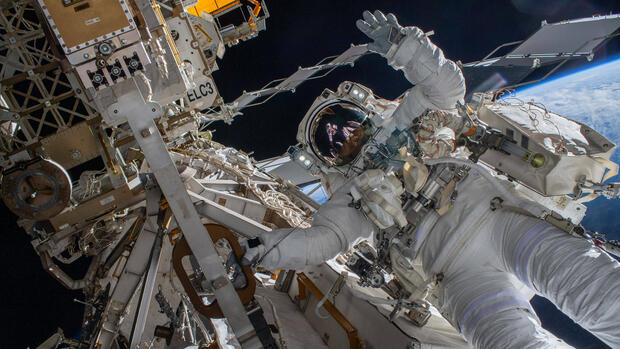Dusseldorf The countdown is on: Mankind is in a new race for the best places in the near-Earth Universe. Above all, the big yellow ball in the night sky promises us that it won’t be able to hide its well-kept treasures from us much longer.
Scientists are already designing scenarios that are tantamount to a science fiction blockbuster. In addition to moon mining, this includes energy from the moon. Can we really hope that one of our biggest problems, the finite nature of energy resources, will soon be solved?
In his current book “The Geography of the Future”, the successful author Tim Marshall takes his readers into the vastness of the orbit and brings them closer to what has long been more than bizarre ideas from Hollywood’s dream factory. This includes the research of Ouyang Ziyuan, geochemist and the most famous face of the Chinese lunar program.
The aerospace expert assumes that a noble gas deposit in moon dust could cover the energy needs of mankind for at least 10,000 years. He sees the astronomical potential in helium-3. Theoretically, it could be used to build a fusion reactor – in the coming decade, as he writes – that would do without irradiated waste.
Scientists like the British particle physicist Frank Close doubt this theory and do not consider the much-vaunted helium variant to be the hoped-for savior. However, author and geopolitical expert Marshall is not concerned with a scientific dispute in his current work, but with another thought: If fabulous treasures are hidden up there between the earth, moon and Mars – whatever it is – we humans will want to benefit from them .
Even private companies have long recognized that there is a lot of money to be made out there. The commercial opportunities are numerous.
(Photo: IMAGO/UPI Photo)
Heads of state and politicians will strive for the greatest possible advantage for their country. But who owns space anyway?
New rivalries, alliances and conflicts
With “Geography of the Future” Marshall builds on his “The Power of Geography” volumes and brings highly complex contexts closer to his readers in understandable language, sometimes quite entertaining. For this he introduces the history of space, describes technical possibilities in the here and now and then turns to the future.
>> Read also: War in space – Germany regulates everything except space travel
Above all, one thought is fundamental: the orbit is the extension of earthly geography. There are corridors for transit, regions with mineral resources or building land, and the best places for satellites on Earth’s orbits.
Seen from this angle, the danger can be sensed as rivalries, alliances and conflicts could soon spread into outer space. And that’s exactly what we earthlings are not well prepared for.
Tim Marshall: The Geography of the Future
dtv publishing company
Munich 2023
320 pages
26 euros
Translation: Lutz-W. Wolff
In recent decades, orbit has been considered a common heritage of humanity (1967 Outer Space Treaty, 1979 Lunar Treaty). But “this idea of the commons, laid down in various noble but unenforceable and outdated treaties, is fraying at the ends,” the author warns. “The battlefield is already taking shape.”
>> Read also: USA shoot down suspected spy balloon – China criticizes use of force
As a former foreign correspondent for television channels such as the BBC and Sky News, Marshall has reported from more than 40 countries – especially from major crisis areas. Now it does not bode well when he speaks of a “battlefield”.
The Shenzhou-10 capsule returns to Earth after a 15-day stay in space.
(Photo: action press)
Nations are beginning to take precautionary measures. For example, the 2021 NATO summit quietly decided to include space as a new treaty area in the alliance partners’ obligations to provide assistance.
Marshall dedicates separate chapters to the major space nations USA, Russia and China. But the structure is even more complex: a total of 80 nations are already present in space with their own satellites. There are also private companies such as Elon Musk’s SpaceX, Arsenal in Russia, the Chinese i-Space and the Japanese Ispace.
Two things are infinite, the universe and human stupidity, but I’m not quite sure about the universe yet. Albert Einstein
With so many players, the risk increases. Marshall outlines some of the possible legal loopholes: For example, national appropriation has been banned in orbit for decades – but is resource extraction “appropriation”?
Or who is liable if a private company destroys a strategically important satellite belonging to another country?
In extreme cases, a question like this also arises: Should Spain take up arms if, for example, a satellite belonging to Elon Musk is shot down over Kenya? Fortunately, the Atlantic Council has so far been reluctant to formulate a decision “on a case-by-case basis”.
It is a strength of Marshall’s current work to make his readers aware of the dangers. Reading his book gives a comprehensive insight. The outlined possible solution strategies, on the other hand, remain rather vague.
For example, who would deny that nations should quickly agree on binding space laws? Together it is also urgently necessary to develop a system to dispose of the increasing number of satellite debris – that would be sensible, there are many reasons for it. But how likely is this “together” by China, Russia and the USA at the moment?
It is to be hoped that Albert Einstein, quoted by Marshall, was wrong at least once when he judged mankind: “Two things are infinite, the universe and human stupidity, but I’m not quite sure about the universe yet.”
More: How geography affects world politics
